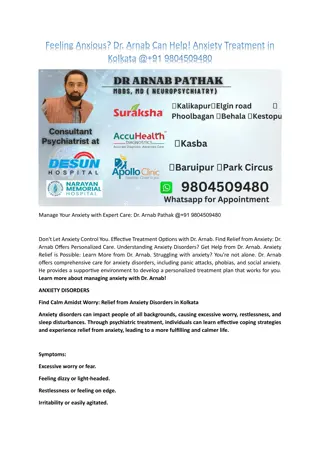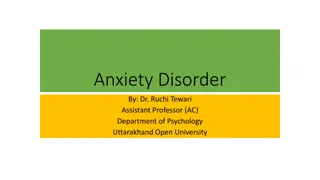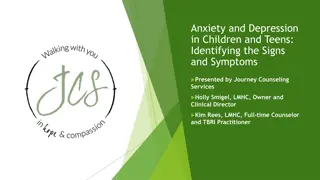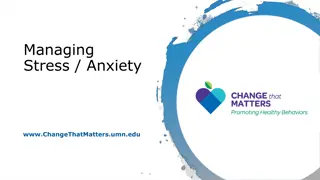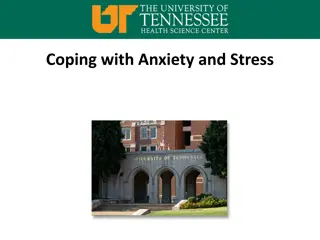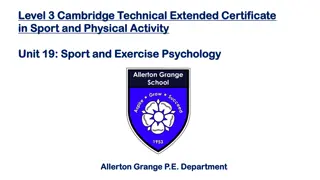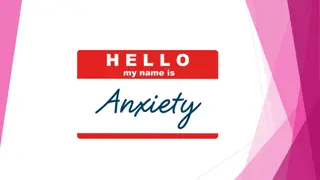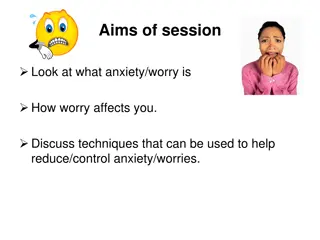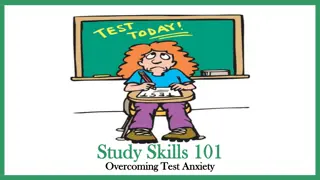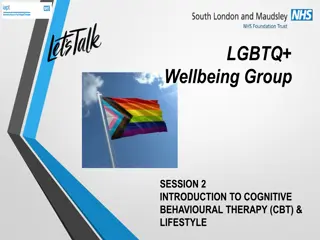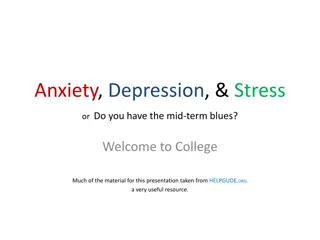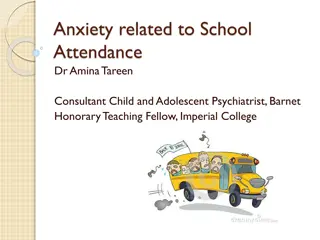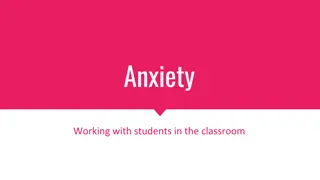Understanding Stress and Anxiety in Youth
Stress and anxiety are common challenges faced by youth today. This presentation by Dr. David Jacobi delves into the causes of stress, its effects on the body, mood, and behavior, and common signs to watch out for. It covers topics like stressors, stress responses, and the impact of stress on youth in school settings. Learn about the importance of recognizing stress-related symptoms and providing appropriate support to help youth navigate these challenges effectively.
Download Presentation

Please find below an Image/Link to download the presentation.
The content on the website is provided AS IS for your information and personal use only. It may not be sold, licensed, or shared on other websites without obtaining consent from the author. Download presentation by click this link. If you encounter any issues during the download, it is possible that the publisher has removed the file from their server.
E N D
Presentation Transcript
Stress and Anxiety in Youth David Jacobi, Ph.D. Lead Psychologist: Child and Adolescent CBT Services Rogers Behavioral Health Sussex Hamilton High School December 3rd, 2019
What we will cover 1. Stress 2. Anxiety Disorders 3. Treatment 4. Symptom Accommodation & Parent Education 5. Anxiety in School Setting 6. Questions
What is stress? o Stressor-is a situation that the person experiences and threatening in some way (e.g., academics, social stress, family discord, world events, trauma, significant life changes) o The threat exceeds one s ability to cope How we interpret a stressor determines whether a stressor is + or and/or the severity of the impact (i.e., is divorce always an unhappy event?; could my reaction to getting a flat tire make my emotional suffering worse?) o Stress Response-complex set of physiological changes that help us deal with the stressor
What does stress look like? o Irritability or moodiness o Stomach/headache o Sleeping or eating too much/too little o Withdrawing from normally enjoyed activities/isolation o Complaints about school o Crying, expressing worries, clinging to a parent o Avoiding parents, abandoning long term friendships o Expressing hostility toward family o Change in academic performance
Stress response: Somatic, Emotional and Behavioral Responses (Mayo clinic, 2019) On your body On your mood On your behavior Headache Anxiety Overeating or undereating Muscle tension or pain Restlessness Angry outbursts Lack of motivation or focus Chest pain Drug or alcohol misuse Fatigue Feeling overwhelmed Tobacco use Change in sex drive Irritability or anger Social withdrawal Stomach upset Sadness or depression Exercising less often Sleep problems
What we know about stress (APA, 2018) o For teens most common sources of stress is school (83%), getting into a good college (69%) and family finances (65%) o Forty percent of teens reported feeling irritable, 36% nervous or anxious, fatigued and 31% overwhelmed o Fifty-one percent said others noticed their stress and 26% said they were short or snapped at someone close due to stress o Other sources: Maintaining social network; juggling school/job/relationships; world events; traumatic events; family issues; other life changes (e.g., move, new school, etc.)
What can caregivers do to help (American Academy of Pediatrics 2012) o Provide a secure home environment o Family routines and family meals-protective effect o Model healthy behavior-manage your own stress in healthy ways o Monitor and limit exposure to certain shows, TV, video games of a violent nature o Keep child in the loop regarding anticipated changes o Listen to your child without being critical o Allow child to have choices and control in their loves o Encourage sleep, exercise, proper diet
When do I seek counseling? Seek counseling if: o Your child is becoming increasingly withdrawn and isolating from you, friends, school or school activities o Is having problems at school: significant academic or social issues o Is struggling to control their anger or is experiencing behavioral outbursts
Nick-17 y/o male Parents have noticed a few changes within the past few weeks that are a change from previous functioning: Nick has been noticeably irritable of late, has spent increasing amounts of time in his room, and isn t socializing as much with friends. He reports some stomach issues, but physician hasn t found any reason for concern. This Fall he has been involved in cross country-will be participating in state CC meet in a week. Has expressed concern/worry about performing up to expectations-doesn t want to disappoint his teammates. He is in the process of completing his applications for college which are due at the end of the month. His grades have been good. He reports worry that he won't be accepted to any of his top schools Nick works part-time on weekends at a local restaurant bussing tables He has a girlfriend whom he sees only sporadically due to his busy schedule. No history of anxiety or depression No problems with school attendance-hasn t missed CC practice. Per Teachers: Have noticed that Nick has been less involved in class discussions of late. Seems distracted Some drop in overall quality of schoolwork but nothing too concerning. Homework is completed on time.
Anxiety in children/teens o Irritability/acting out/tantrums o Clingy/difficulty separating from parent (children) o Difficulty with sleep (children wanting to co sleep); waking in the middle of the night; bad dreams o Bed wetting (children) o Somatic symptoms: headache, stomachache o Unwilling to try new things o Avoiding normal activities such as being with friends, going to school and being away from home Separation anxiety, specific fears, social fears/shyness, worry common in young children Will talk about school related signs and symptoms later
When is it an anxiety disorder? o Normal for kids of all ages to be nervous and anxious about returning to school, completing homework assignments, taking tests and being involved in extracurriculars o Normal anxiety is usually transient o Anxiety that is problematic is associated with increased levels of distress, tends to be chronic, and leads to interference in multiple areas of functioning such as school, home and socially o Usually the child learns to avoid those persons, places or things that trigger their anxiety
Anxiety vs. Fear o Anxiety-Apprehension about a future threat o Fear- Response to an immediate threat o Both involve physiological arousal o Both can be adaptive Fear triggers fight or flight Anxiety can increase preparedness Yerkes Dodson (next slide)
Yerkes Dodson Curve Comfort Anxiety
Epidemiology of Anxiety Disorders o Most common emotional/behavioral disorder in childhood o Incidence 10-15% of children and adolescents o About 8% of teens ages 13 18 have an anxiety disorder, with symptoms commonly emerging around age 6. However, of these teens, only 18 percent received mental health care o Co-morbid psychiatric disorders: Other anxiety disorders ADHD Autism Spectrum Disorder Substance use Depression(kids-somatic complaints, acting out, aggression) Eating disorders
What are the anxiety disorders? o Generalized anxiety disorder (GAD) o Separation anxiety disorder o Social anxiety disorder o Selective mutism o Panic disorder Obsessive-compulsive disorder (OCD) (obsessive compulsive and related disorders) ex. BDD, Hair pulling disorder, Hoarding disorder Post-traumatic stress disorder (trauma and stressor related disorders) ex. RAD, Disinhibited social engagement disorder, adjustment disorders
Generalized Anxiety Disorder o Excessive/difficult to control worry (for at least 6 mos) About: welfare and safety of family and friends, finances, relationships, punctuality, school performance, world events o Associated symptoms: Irritability, muscle tension, fatigue, unable to sit still, poor concentration and sleep o Not easily reassured o May throw tantrums related to anxiety o Poor concentration and attention, fidgety May present similar to a child with ADHD
Separation Anxiety o Excessive anxiety focused on separating from home or parent o More commonly diagnosed in pre-pubertal children More common in 5-7 and 11-12-year olds with transition into elementary and middle school o Typically occurs following a significant change or major life event (e.g., divorce, illness, move) o Behaviors: Clinging/shadowing behavior, nightmares, expressing fear of losing loved one, school refusal, somatic complaints
Social Anxiety Disorder o Excessive fear in social situations where child is exposed to unfamiliar people/evaluation by others (e.g., Raising hand in class, class presentations, friendships) o Tremendous concern about social failure/embarrassment/humiliation o Fear is excessive and unreasonable o Avoidance or endurance with extreme distress o Interference in functioning (e.g., Unable to attend school, few if any friendships, isolated from social activities)
Selective Mutism o Children either talk minimally or not at all in certain settings or situations that are part of their daily lives (e.g., with teachers and classmates, meeting new people (especially adults) o Reflects underlying problems with anxiety o Often inadvertently reinforced speaking for the child permitting the use of nonverbal communication o Considered a more severe form of social phobia
Panic Attacks vs. Panic Disorder Panic attacks: o Sudden, discrete episodes of intense fear, Intense desire to escape, doom o Activation of autonomic nervous system (Fight or flight) o Duration 15-30 minutes o Common 20-30% of adult population Panic Disorder: o Recurrent panic attacks o Inter-episode worry about having a panic attack o Worry about implications and consequences o Changes in behavior o More common in adolescents
Post-traumatic Stress Disorder o Exposure to an actual or threatened death, serious injury or sexual violence. o Re-experiencing of the trauma (e.g., play echoing trauma theme, frightening dreams, reenactment of trauma in play) o Avoidance of thoughts, feelings people, places that are associated with the trauma, anhedonia, feelings of detachment o Negative changes to thoughts and mood(e.g. increased negative emotions such as fear guilt sadness; anhedonia; socially withdrawn; decreased expression of positive emotions) o Arousal (e.g., irritability, hyper vigilance, exaggerated startle, poor concentration and sleep)
Diagnosis: What are Obsessions? o Recurrent, intrusive, unwanted thoughts, images and impulses. o They are NOT excessive worries about real life problems. Patients often describe obsessions as silly, senseless, bizarre o Because obsessions are unwanted and distressing, people try to resist them, get rid of them, or reduce their distress in some way: avoidance of triggers distraction compulsive behaviors or thoughts
Examples of Obsessions o Fear of Contamination or Germs (chemicals, pets/insects, sticky substances, doorknobs, public bathrooms) o Fear of Harm or Danger (to self, loved ones) o Fear of Loss (books, papers, receipts, trash) o Need for Symmetry (need to have room organized in a certain way) o Need for Perfection (need for certainty, fear of anxiety)
Diagnosis: What are Compulsions? o A compulsion is a behavior or mental act that a person feels driven to perform over and over again to prevent or reduce anxiety, discomfort or distress to prevent something bad from happening o Performed in response to an obsession o Often performed according to rigid rules or until it feels just right
Examples of Compulsions o Washing/Cleaning (hand washing, grooming, toilet routine, brushing teeth) o Checking (stove, light switches, door locks, reassurance seeking, calling Mom at work, going over homework to make sure it is done correctly) o Hoarding (collecting trash, saving receipts, old magazines/books, other old, useless or dated materials) o Ordering/Arranging (books and CDs on shelf, pillows on bed, icons on computer) o Repeating Rituals (rereading, rewriting, retracing steps, or until feels just right )
What is not OCD? o Pathological gambling (impulse-control). o Kleptomania (impulse-control). o Certain substance abuse disorders o Video game addiction Thoughts are not unwanted. Derive pleasure from compulsive act. Typically, only want to stop because of negative consequences of acts.
Jane-14 y/o female Poor school attendance and subsequent academic decline Per Parents Hx of anxiety since childhood Temper outbursts, irritability, sadness, crying, and power struggles Increased worry about being bullied, potential for potential for disasters (e.g. school shootings) Fears about starting HS, fitting in and passing her classes despite no hx of academic difficulty Confined to home but a few activities with church youth group School Avoidance school-shootings or bomb threats at schools in the news Per Teachers Reports feelings of being left out and complains of meanness and possible exclusion by several peers Appears connected to friend Jennifer Questions: clarification of assignments, checking to ensure she has properly understood the material, confirmation her answers are correct, college preparedness Missed school or gone home early complaining of headaches or stomach aches
Cognitive-behavioral model of anxiety Physical feelings/emotions e.g., anxiety, tummy ache, headache, racing heart Behaviors Thoughts e.g., isolating, avoidance e.g., Catastrophizing/ bad things are likely to happen
Cognitive-Behavioral Model High We KNOW this. (Anxiety) Low (Time)
Cognitive-Behavioral Model High Safety behavior (Anxiety) If this is your response to the onset of anxiety, what do you NOT KNOW? Low 60 sec (Time)
Cognitive-Behavioral Model High (Anxiety) Low (Time)
Cognitive-Behavioral Model High (Anxiety) Low (Time)
Exposures-confronting fears GAD-worry exposure (imaginal exposure to feared outcomes), raise hand in class when not confident, choose movie to watch, cold call a friend, spend X amount of time on homework) Separation anxiety-Exposure to time away from parent or safe place, reducing access to phone to contact parent Panic/Agoraphobia-interoceptive exposures (hyperventilate, spin in chair), in vivo exposures to avoided situations (supermarket, theatres) Social anxiety-social exposures (call a business, ask for time, wear conspicuous clothing, presentations) Selective mutism-graded exposure involving interactions with others. Gradually work to increase social contact (e.g., increase voice volume, eye contact, initiating contact, etc)
General guidelines to help children manage anxiety o Encourage child to confront fears, problem solve and thought challenge. Don t try to remove the stressor to alleviate anxiety o Don t avoid the things that make your child anxious. Avoidance only makes the anxiety worse o Don t present an overly optimistic view of the world. It is possible that many of the things your child fears could happen (e.g., failing a test, accidents, illnesses). Focus on managing anxiety so it doesn t become a bigger problem. o Validate their fears in a way that isn t reassuring or dismissive. Show that you understand their experience and help them to move forward to face their fears, problem solve and thought challenge
Contd o Be mindful of your response when your child is anxious. Are you showing signs of anxiety? Are you wanting to alleviate your child's anxiety because it will also reduce your anxiety? o Having a plan in advance can help some kids (e.g., return to school, dealing with bullies, academic concerns) o As a teacher or parent are you modelling healthy ways of managing your own anxiety?
Symptom Accommodation & Parent Education
Accommodation in Anxiety Disorders: Symptom accommodation: actions taken by the family members to acquiesce to the child s demands (e.g., allowing child to miss activities to minimize anxiety), provide reassurance to the child (e.g., answer questions repeatedly), decrease child s responsibility (e.g., minimize attempts at discipline), or assist with or complete tasksfor the child (e.g., provide extra assistance with homework, chores, and so on) o Applies to adults and non-family members as well
Family Accommodation-More Examples Opening doors or turning on light switches Changing your routine to be available to answer your child s calls or texts from school Avoidance -allowing your child to avoid certain activities, places, objects or persons because of OCD/anxiety Checking Having to check the closets, electrical items, door locks, etc. Tolerating your child s aggression
More than 97% of families accommodate! (In reality all families accommodate)
Accommodation in Anxiety Disorders Examples: o Child with separation anxiety may expect her parents to sleep next to her or expect frequent contact with her parents during the day while she is at school. o Individual with social anxiety may ask parents, siblings, and/or friends to make phone calls or speak for her. o Teen with generalized anxiety disorder may receive frequent reassurance from others that they are safe and may have others change their behavior due to worry (e.g., loved one agrees to not drive somewhere when it s raining due to patient request). o Teen with panic disorder may have his parent accompany him to public or crowded places, or request parent to avoid this place.
Why families/others accommodate: o It s easier in the beginning o You think it is helpful o You fear the child will feel unsupported if you don t accommodate o You feel guilty or mean if you don t accommodate o It s hard to tolerate the child s anxiety/distress o You fear the child s behavioral response
Whats the problem with accommodating? o Associated with poorer treatment outcomes in children and adults with anxiety Reduces effectiveness of CBT and long-term outcomes o Accommodation conflicts with goals of CBT Prevents habituation (the treatment effect) o Limits opportunities for child to learn that feared consequences are unlikely to happen o Reduces student s motivation to change
Reassurance: A form of accommodation o Reassurance seeking involves: A child asking lots questions Asking the same question over and over in order to hear from you that things will be okay o Examples of reassurance seeking questions: Are you upset with me? Did I say something wrong? Was that a stupid question? Do you think something bad will happen to them? I don t know what do you think we should do? (looking for others to make decisions) Does that look right to you?
Ways to reduce reassurance What do you think? Maybe yes, maybe no, I don t know. 1. Give your child the opportunity to answer the question themselves 2. Insert a predetermined length of time before answering questions to increase tolerance for uncertainty Limit the number of worry questions/day/hour: One worry question per hour 3.Insert a predetermined length of time before answering questions to increase tolerance for uncertainty Delay reassurance: ask child to rate their fear
How To Replace Reassurance Validation vs. Reassurance Validation: verbal or nonverbal communication to another person that his or her emotions, thoughts, and behaviors have causes and are understandable given the situation or individual s learning history; verifying the facts of a situation. Reassurance:the act of removing doubt or fear; a verbal or nonverbal action that is done in an attempt to reduce someone s doubt, fear, or distress (e.g., anything that artificially reduces anxiety or attempts to offer certaintywhen certainty is not available).




